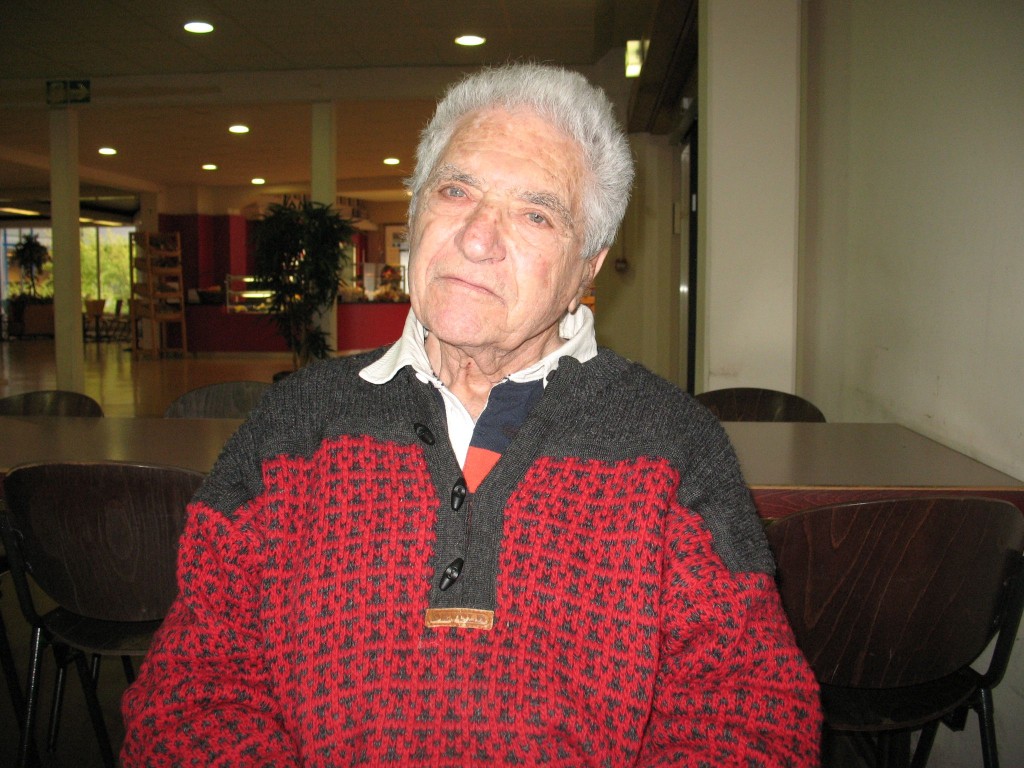
A Conversation with Nobel Laureate Dr. Jack Steinberger
On January 27, 2014, I had the privilege and pleasure of meeting with Dr. Jack Steinberger at CERN, the European Organization for Nuclear Research, in Geneva, Switzerland. In a wide-ranging conversation, we discussed nuclear disarmament, nonproliferation, particle physics, great scientific achievements, and solar thermal power plants. Here, I give a summary of the discussion with Dr. Steinberger, a Nobel physics laureate, who serves on the FAS Board of Sponsors and has been an FAS member for decades.
Dr. Steinberger shared the Nobel Prize in 1988 with Leon Lederman and Melvin Schwartz “for the neutrino beam method and the demonstration of the doublet structure of the leptons through the discovery of the muon neutrino.” Dr. Steinberger has worked at CERN since 1968. CERN is celebrating its 60th anniversary this year and is an outstanding exemplar of multinational cooperation in science. Thousands of researchers from around the world have made use of CERN’s particle accelerators and detectors. Notably, in 2012, two teams of scientists at CERN found evidence for the Higgs boson, which helps explain the origin of mass for many subatomic particles. While Dr. Steinberger was not part of these teams, he helped pioneer the use of many innovative particle detection methods such as the bubble chamber in the 1950s. Soon after he arrived at CERN, he led efforts to use methods that recorded much larger samples of events of particle interactions; this was a necessary step along the way to allow discovery of elusive particles such as the Higgs boson.
In addition to his significant path-breaking contributions to physics, he has worked on issues of nuclear disarmament which are discussed in the book A Nuclear-Weapon-Free World: Desirable? Feasible?, (was edited by him, Bhalchandra Udgaonkar, and Joseph Rotblat). The book had recently reached its 20th anniversary when I talked to Dr. Steinberger. I had bought a copy soon after it was published in 1993, when I was a graduate student in physics and was considering a possible career in nuclear arms control. That book contains chapters by many of the major thinkers on nuclear issues including Richard Garwin, Carl Kaysen, Robert McNamara, Marvin Miller, Jack Ruina, Theodore Taylor, and several others. Some of these thinkers were or are affiliated with FAS.
While I do not intend to review the book here, let me highlight two ideas out of several insightful ones. First, the chapter by Joseph Rotblat, the long-serving head of the Pugwash Conferences, on “Societal Verification,” outlined a program for citizen reporting about attempted violations of a nuclear disarmament treaty. He believed that it was “the right and duty” for citizens to play this role. Asserting that technological verification alone is not sufficient to provide confidence that nuclear arms production is not happening, he urged that the active involvement of citizens become a central pillar of any future disarmament treaty. (Please see the article on Citizen Sensor in this issue of the PIR that explores a method of how to apply societal verification.)
The second concept that is worth highlighting is minimal deterrence. Nuclear deterrence, whether minimal or otherwise, has held back the cause of nuclear disarmament, as argued in a chapter by Dr. Steinberger, Essam Galal, and Mikhail Milstein. They point out, “Proponents of the policy of nuclear deterrence habitually proclaim its inherent stability… But the recent political changes in the Soviet Union [the authors were writing in 1993] have brought the problem of long-term stability in the control of nuclear arsenals sharply into focus. … This development demonstrates a fundamental flaw in present nuclear thinking: the premise that the world will forever be controllable by a small, static, group of powers. The world has not been, is not, and will not be static.”
Having laid bare this instability, they explain that proponents of a nuclear-weapon-free world also foresee that minimal deterrence will “encourage proliferation” because nations without nuclear weapons would argue that if minimal deterrence appears to strengthen security for the nuclear-armed nations, then why shouldn’t the non-nuclear weapon states have these weapons. After examining various levels for minimum nuclear deterrence, the authors conclude that any level poses a catastrophic risk because it would not “eliminate the nuclear threat.”
While Dr. Steinberger demurred that he has not actively researched nuclear arms control issues for almost 20 years, he is following the current nuclear political debates. He expressed concern that President Barack Obama “has said that he would lead toward nuclear disarmament but he hasn’t.” Dr. Steinberger emphasized that clinging to nuclear deterrence is “a roadblock” to disarmament and that “New START is too slow.”
On Iran, he said that if he were an Iranian nuclear scientist, he would want Iran to develop nuclear bombs given the threats that Iran faces. He underscored that if the United States stopped threatening Iran and pushed for global nuclear disarmament, real progress can be made in halting Iran’s drive for the latent capability to make nuclear weapons. He also believes that European governments need to decide to “get rid of U.S. nuclear weapons based in Europe.”

Another major interest of his is renewable energy that can provide reliable, around the clock electrical power. In particular, he has repeatedly spoken out in favor of solar thermal power. A few solar thermal plants have recently begun to show that they can generate electricity reliability even during the night or when clouds block the sun. Thus, they would provide “baseload” electricity. For example, the Gemasolar Thermosolar Plant in Fuentes de Andalucia, Spain, has an electrical power of 19.9 MW and uses a “battery” to generate power. The battery is a molten salt energy storage system that consists of a mixture of 60 percent potassium nitrate and 40 percent sodium nitrate. This mixture can retain 99 percent of the thermal energy for up to 24 hours. More than 2,000 specially designed mirrors, or “heliostats,” arrayed 360 degrees around a central tower, reflect sunlight onto the top part of the tower where the molten salt is heated up. The heated salt is then directed to a heat exchanger that turns liquid water into steam, which then spins a turbine coupled to an electrical generator.
Dr. Steinberger urges much faster accelerated development and deployment of these types of solar thermal plants because he is concerned that within the next 60 years the world will run out of relatively easy access to fossil fuels. He is not opposed to nuclear energy, but believes that the world will need greater use of true renewable energy sources.
Turning to the future of the Federation of American Scientists, Dr. Steinberger supports FAS because he values “getting scientists working together,” but he realizes that this is “hard to do” because it is difficult “to make progress in understanding issues” that involve complex politics. Many scientists can be turned off by messy politics and prefer to stick within their comfort zones of scientific research. Nonetheless, Dr. Steinberger urges FAS to get scientists to perform the research and analysis necessary to advance progress toward nuclear disarmament and to solve other challenging problems such as providing reliable renewable energy to the world.
The grant comes from the Carnegie Corporation of New York (CCNY) to investigate, alongside The British American Security Information Council (BASIC), the associated impact on nuclear stability.
Satellite imagery of RAF Lakenheath reveals new construction of a security perimeter around ten protective aircraft shelters in the designated nuclear area, the latest measure in a series of upgrades as the base prepares for the ability to store U.S. nuclear weapons.
It will take consistent leadership and action to navigate the complex dangers in the region and to avoid what many analysts considered to be an increasingly possible outcome, a nuclear conflict in East Asia.
How the United States responds to China’s nuclear buildup will shape the global nuclear balance for the rest of the century.